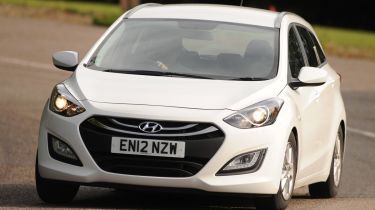Hyundai i30 Tourer
Tourer has already won one test, so can it come out on top once again?
If you want an efficient, practical estate, the i30 should be on your shortlist. What it lacks in desirability it makes up for with low running costs, plus an interior that should stand up to years of abuse. It’s a car for your head rather than your heart, but in this market that’s no bad thing.
Having seen off mainstream rivals from Renault and VW in our previous test, the Hyundai i30 Tourer is the car to beat here. But it starts out on the back foot, as our plain Active model isn’t as interesting to look at as the Kia.
True, the estate body is neatly integrated into the ‘fluidic sculpture’ family design language, and the well proportioned rear overhang does an excellent job of hiding the 185mm of extra length. Yet the tiny 15-inch alloys and lack of chrome detailing mean the Hyundai isn’t as attractive as the Cee’d.
Still, the i30 is better proportioned than the larger Chevrolet and standard LED lights add a premium gloss to its sensible image.
Inside, it’s slightly more spacious than the Cee’d, despite sharing the same chassis. With the seats in place, there’s 528 litres of capacity – 18 litres more than the Kia. With the rear bench folded flat, it offers an identical 1,642 litres. However, the i30’s rear seats are backed with hard plastic rather than cloth, which looks cheap but is likely to be more robust.
Used - available now
The Tourer is 20mm shorter and 15mm taller than the Cee’d SW, too, and although the cars’ wheelbases are identical, when we got the tape measure out the Hyundai had a slight advantage in terms of head and legroom.
Up front, the i30 uses the same quality materials as the Kia, and the fit and finish of the upright dash is miles ahead of the Cruze. The deeply cowled dials and flared air vents are smart enough, but you’ll have to stretch to reach some of the audio and ventilation controls, meaning it’s not as user-friendly as the more driver-orientated Cee’d SW.
In basic Active trim, the Hyundai is nowhere near as well equipped as the Chevrolet, either. Although essentials like Bluetooth and cruise control are here, and the multifunction steering wheel prevents the cabin from looking too basic, you’ll need to upgrade to the Style model to benefit from practical extras like a luggage net and pockets in the front seatbacks, plus luxury kit like cornering headlights and auto wipers.
Regardless of which trim level you choose, the i30 still has the same smooth and refined dynamics that set the Kia apart in this test. If anything, the small wheels make it even more comfortable, and although the 109bhp i30 has 17bhp less power than its sister car, an identical torque figure of 260Nm meant it felt just as quick at the track – it matched the Kia from 0-60mph and during our in-gear tests as well.
There was more body roll in corners and the car ran out of front grip sooner than the Cruze thanks to its eco tyres, but this isn’t something you’d notice in normal driving. The only blot on its dynamic copybook were the brakes: the i30 took 53.5 metres to stop from 70mph – several more than the others.
In this spec, the Hyundai was also cheaper to buy than its rivals, and would cost the least to insure, while its five-year warranty matches the Chevrolet’s. However, it depreciates more than the Kia over three years, and while our car had covered nearly 2,000 more miles than the Cee’d, it trailed at the pumps with 40.4mpg.
Overall, this functional, practical and discreetly styled estate car remains a very impressive choice. Can it win another test?











